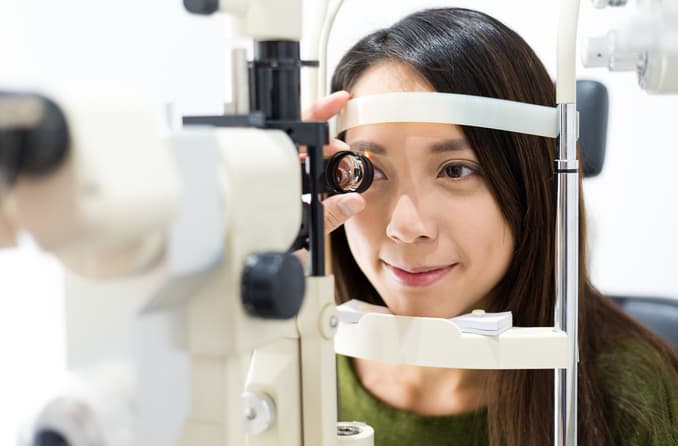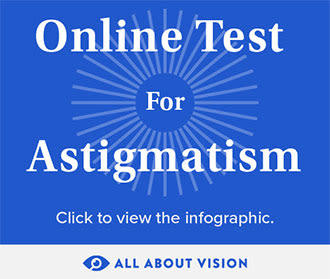What to expect in an astigmatism test

Astigmatism is a refractive error that causes blurred or distorted vision at all distances. Astigmatism is common among adults and children and can be corrected with eyeglasses, contact lenses and refractive surgery (LASIK, for example). But how do you know if you have astigmatism?
Astigmatism testing is performed during a comprehensive eye exam at your eye doctor’s office. (Eager to assess your vision ahead of your appointment? See our downloadable astigmatism chart below).
Here’s what to expect from an astigmatism test:
What is an astigmatism test?
If you experience symptoms such as blurred or distorted vision, headaches and/or eye strain/discomfort, there’s a chance you could have some form of astigmatism.
During a routine exam, your eye care provider or an assistant will perform the following tests to check for astigmatism:
Refraction
As its name suggests, a refraction is a test to see if you have a refractive error (including astigmatism). There are two types of refraction in an eye exam: an automated refraction (a very quick test, usually performed by an assistant) and a manual refraction (performed by an assistant or by your eye care provider, usually after an automated refraction has been done).
During the manual refraction, you will look at an eye chart as pairs of lenses are placed in front of your eyes, and you’re asked, “Which lens makes things clearer — lens 1 or lens 2?” (or something to that effect).
Visual acuity test
During your eye exam, your visual acuity (20/40, 20/20, etc.) will be tested with an eye chart. This measurement will be performed while you wear your current eyeglasses (or without corrective lenses if you don’t currently wear them) and then again after a manual refraction.
Your visual acuity test is useful to determine the severity of your astigmatism or other refractive error.
Keratometry
In this astigmatism test, an instrument called a keratometer is used to measure the curvature of your cornea. In most cases, astigmatism is caused by unequal curves in different meridians of the cornea.
Think of your eyes like the front of a clock; straight lines that connect numbers on the opposite side of the clock. 12 and 6, 3 and 9, etc. are the corneal meridians.
SEE RELATED: Astigmatism: Effects on light and night driving
Chart for at-home astigmatism test
If you’re eager to screen yourself for astigmatism at home, you can do so with a special eye chart. The way you see the lines on the chart below can indicate whether or not you have astigmatism.
Start by positioning yourself about a metre away from your screen. If you already wear glasses, you can keep them on for this screening.
Cover your left eye first, while concentrating on the image with your right eye. Focus on the darkness and thickness of the lines in the image. Then cover your right eye while you concentrate on the image with your left. Again, take note of the darkness and thickness of the lines.
Do some lines appear bolder than others? If so, you could have astigmatism.
If you think you may have astigmatism based on this screening, be sure to follow up with an eye care provider, who can confirm the assessment and help you find adequate correction.
SEE RELATED: Astigmatism: Q&A
Are online astigmatism tests accurate?
It’s important to note that an at-home astigmatism chart can suggest you have astigmatism, but it is not a replacement for a comprehensive exam administered by an eye care provider.
During an at-home astigmatism test, you position yourself about a metre away from your screen, alternate covering your left and right eyes, and take note of the thickness of a given set of lines. This strategy can certainly help identify symptoms of astigmatism, as an initial approach.
If results from the at-home screening show signs of astigmatism, you should follow up with an eye care provider as soon as possible. Your eye care provider can determine exactly how much astigmatism you have and discuss the best treatment options with you.
After astigmatism testing
If you receive a diagnosis for astigmatism, your eye care provider may recommend one of many treatment options. The most efficient treatment will depend on each individual case, but the following are recommended most often:
Eyeglasses or contact lenses
PRK (photorefractive keratectomy)
The only way to receive these legitimate treatments is under the care of an eye care provider. Whether your online astigmatism test has prompted you or it’s simply time for your next routine eye exam, consulting an eye care provider will help you determine your next steps.
OVERDUE FOR AN EYE EXAM? Schedule an appointment today.
Page published on Tuesday, 17 May 2022







